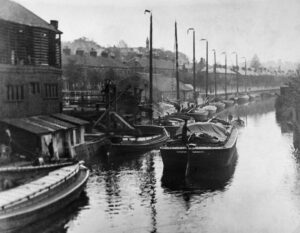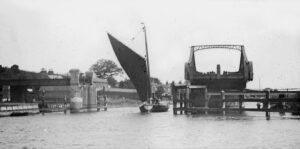Broads Uncovered: The Trading Wherries

The first trading wherries began to appear on the waterways of the Broads from 1700 onwards and by 1830 they were the boat of choice to transport goods such as coal, bricks, timber, wheat and malt to and from the ports, cities, towns and villages throughout the region. This does not mean there were no boats working these waters before 1700, far from it. The 200 km of waterways in the Broads National Park have served as vital transport and trade routes throughout history from before the Romans through until the early 1900’s. It is only in the last 150 years that moving around on land, because of improved roads and railways, has become more practical and quicker than going by water.
The Rise of the Trading Wherries

Prior to the trading wherries Norfolk Keels were the work horse of the Broads from the medieval period right up until the 1800’s. They were big boats up to 21m long and could carry 80 tons of cargo but, they were hard to manoeuvre and needed a following wind. When the region’s boat builders began to adopt the Dutch fore and aft rig with gaff mainsail in the 1800’s the Norfolk Keels’ days were numbered. Boats with the new rig were unaffected by wind direction, were fast, light and highly manoeuvrable even when 18m long and carrying 40 tonnes of cargo. The improved speeds and efficiency of these new boats, the trading wherries, meant that by 1830 the heavier, slower Keels had vanished from the Broads waterways. At the peak of their dominance there were 300 trading wherries sailing the waterways of the Broads.
Post Industrial Revolution

Just as the Norfolk Keels lost out to the trading wherries, the trading wherries in turn lost out to the giants of the Industrial era – the trains. From the 1870’s the number of trading wherries on the waterways began to decline and by 1949 there were none left. The 7 hour journey from Great Yarmouth to Norwich by wherry was now only an hour by train which was also able to haul much greater loads, and in business, time is money. Some trading wherries branched out as boats for tourists to hire and sail on in the summer. Boat builders, responded to this demand for sailing boats for pleasure and tourism, by modifying the trading wherry design and building Wherry Yachts and Pleasure Wherries. Most trading Wherries ended their days de-masted and used to carry mud when the rivers and broads were dredged. Many were sunk and used as support for the banks of the region’s rivers and broads.

Today, thanks to the determined efforts of some very dedicated people, there are 2 trading wherries still sailing: the Maud, run by the Wherry Maud Trust and the Albion, run by the Norfolk Wherry Trust as well as 6 Pleasure Wherries/Wherry Yachts.

The Prezi Presentation below explores the world of the Broads’ trading wherries and the men and women who lived and worked on them. Throughout the presentation the wherryman, William Royall (pictured here) will be your guide. All the facts, stories and tales he tells you are true and did happen, it’s just they may not have happened directly to him! His is the face we chose to bring the wherrymen of the past to life.
We would like to thank Wherry Maud Trust and Mike Barnes (“Yachting on the Norfolk Broads”) for their kind permission to use photos from their websites, and Picture Norfolk run by Norfolk County Council Library and Information Service who supplied all the black and white images of the wherries.
